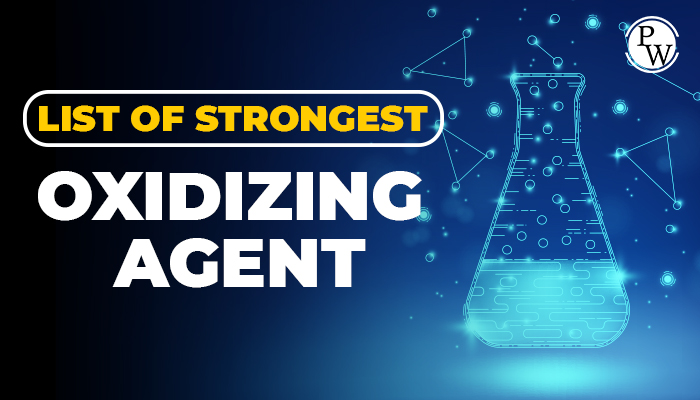
List of Strongest Oxidizing agent
Aug 26, 2022, 16:45 IST
The substances that cause oxidation, namely electron loss, are called oxidizing agents, while those that cause the reduction or gain of electrons are called reducing agents.
Some substances are better oxidizing agents than others. It all depends on how easily an object absorbs electrons and thus causes another object to lose electrons. The most effective non-metals are the most effective oxidizing agents. Because of its abundance in the atmosphere, oxygen gas (O 2 ) is the most common oxidizing agent.
Fluorine (F) is the most strong oxidizing agent, and some Halogens are also strong oxidizing agents. Fluorine is such a good oxidizing agent that metals, quartz, asbestos, and even flame-retardant fluids are present.
In the Labs, sulfuric acids and concentrated nitric acids are both oxidizing compounds used to react with less active metals. Other oxidizing agents used in the lab are potassium permanganate, potassium dichromate, hydrogen peroxide, and Halogens.
There are also few strong reducing agents among the elements. Hydrogen (H 2 ) and the components in Group 1 and Periodic Table are the most effective reducing agents. Hydrogen was among the first things to be considered as a reducing agent.
Because carbon (C) and sulfur (S) combine easily with oxygen, they are also effective mitigation agents, especially at high temperatures. Metallic hydrides such as CaH 2 , NaH and LiAlH 4 are also good reducing agents.
The most reducing agents are the weakest oxidizing agents, and the strongest oxidizing agents are the most reducing ones. If the sodium atom (Na) is a strong reducing agent, the sodium ion (Na + 1 ) should be a weak oxidizing agent. Or if oxygen atoms are strong oxidizing, then ion oxide (O -2 ) is a weak reducing agent.
Please consider that the oxidizing agent and the reducing agent are related conditions. Many substances can work as alternatives depending on the reactant they are packaged.
For example, a substance with a weak oxidizing agent will act as if a strong oxidizing agent is reacting with a strong reducing agent. A weak oxidizing agent will behave as a reducing agent when reacting with a strong oxidizing agent.
Organic chemistry consist of large number of oxidizing agents have different use and applications. This page consist of list of all oxidizing agent used in organic chemistry with its products and mechanism. Do follow Chemistry Doubts and Chemistry Formulas prepared by Physics Wallah.

Find below Strongest Oxidizing Agent list
- OsO 4
- RCOOOH
- KMnO 4 & K2Cr 2 O 7
- Chromic Acid
- PCC
- PDC
- Colllins Reagent
- Mn0 2
- Oppenauer Oxidation
- Swern Oxidation
- Periodic Acid
- Lead Tetraacatate
- Ozonolysis
- Etard Oxidation
- Caro’s acid (H2SO5)
- Dakin Reaction
- Cu
- Phenol Oxidation
- SeO 2
Get detail Mechanism and use of Strongest Oxidizing agent









